Select an inequality for the shaded region shown in the figure.
?
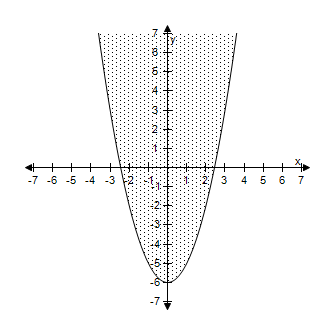
?
A.
B.
C.
D.
E.
Answer: E
You might also like to view...
Determine whether the sequence of vertices is i) a walk, ii) a path, iii) a circuit in the given graph. G ? F ? H ? B ? F ? C ? G
G ? F ? H ? B ? F ? C ? G
A. None of these B. Walk and path C. Walk only D. Walk, path, and circuit
Solve by graphing. Label the axes and show where the solution is located on the graph.The value, v, in hundreds of dollars, of Juan's computer is approximated by  where t is the number of years since he first bought the computer.(a) Sketch the graph the equation.
where t is the number of years since he first bought the computer.(a) Sketch the graph the equation.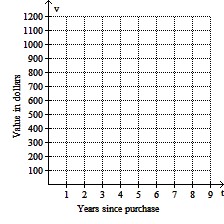 (b) Find the missing coordinate for the ordered pair solution (4, ? ).(c) Interpret the point from part (b).(d) Find and interpret the y-intercept.(e) What does the x-intercept represent in this problem?
(b) Find the missing coordinate for the ordered pair solution (4, ? ).(c) Interpret the point from part (b).(d) Find and interpret the y-intercept.(e) What does the x-intercept represent in this problem?
A. (a)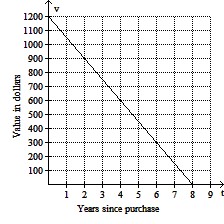
(b) (4, 600); (c) The value of Juan's computer
is $600 after 4 years of ownership.; (d) The
y-intercept, (0, 1200) indicates that the value
of Juan's computer was $1200 when he first
bought it.; (e) The x-intercept, (8, 0)
indicates that after 8 years, Juan's computer
will be worthless ($0).
B. (a)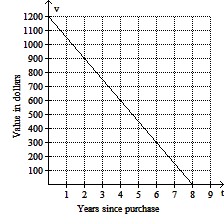
(b) (4, 1800); (c) The value of Juan's computer
is $1800 after 4 years of ownership.; (d) The
y-intercept, (0, 1200) indicates that the value
of Juan's computer was $1200 when he first
bought it.; (e) The x-intercept, (8, 0)
indicates that after 8 years, Juan's computer
will be worthless ($0).
C. (a)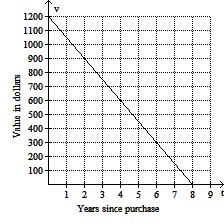
(b) (4, 1800); (c) The value of Juan's computer
is $1800 after 4 years of ownership.; (d) The
y-intercept, (0, 1200) indicates that the value
of Juan's computer was $1200 when he first
bought it.; (e) The x-intercept, (12, 0)
indicates that after 12 years, Juan's computer
will be worthless ($0).
D. (a)
(b) (4, 600); (c) The value of Juan's computer
is $600 after 4 years of ownership.; (d) The
y-intercept, (0, 1200) indicates that the value
of Juan's computer was $1200 when he first
bought it.; (e) The x-intercept, (12, 0)
indicates that after 12 years, Juan's computer
will be worthless ($0).
Solve using the addition principle.-7 = 5 + f
A. 12 B. -2 C. -12 D. 2
Determine whether the two binomials are or are not opposites.2x - 3 and 3x - 2
A. Opposites B. Not opposites




